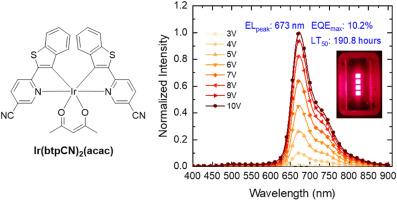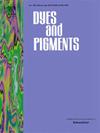氰基取代的双((苯并噻吩-2-基)吡啶)(乙酰丙酮)铱配合物,用于在 673 纳米波长发射高效稳定的深红色有机发光二极管
IF 4.1
3区 工程技术
Q2 CHEMISTRY, APPLIED
引用次数: 0
摘要
本研究探讨了氰基取代的双((苯并噻吩-2-基)吡啶)(乙酰丙酮)铱配合物的开发,特别是 Ir(btpCN)2(acac),用于在 673 纳米波长发射高效稳定的深红色有机发光二极管(OLED)。新的发射体 Ir(btpCN)2(acac)是通过在 btp 配体的吡啶分子的元位置进行战略性氰基取代,利用其发射光谱与由 BCzPh 和 CN-T2T 组成的赋形剂主吸收光谱之间的有利重叠,实现红移发射。采用 Ir(btpCN)2(acac)作为发射体的 OLED 器件的峰值外部量子效率(EQE)为 10.2%,发射波长为 673 纳米。值得注意的是,这些器件表现出卓越的工作稳定性,在初始亮度为 200 cd m-2 的情况下,寿命(LT50)为 190.8 h,是文献报道的深红色有机发光二极管中最高的。这种出色的稳定性是在不影响器件性能的前提下实现的,这使得 Ir(btpCN)2(acac)成为一种极具商业应用前景的候选材料。此外,Ir(btpCN)2(acac) 的简单合成过程进一步提高了其广泛应用的潜力。总之,我们的研究结果凸显了氰基取代的 Ir 复合物在制造高效、稳定和具有商业价值的深红色有机发光二极管方面的潜力。Ir(btpCN)2(acac)在效率、稳定性和易合成性方面的均衡表现,标志着在开发适用于光疗和其他需要可靠深红光源的应用的有机发光二极管技术方面取得了重大进展。本文章由计算机程序翻译,如有差异,请以英文原文为准。

Cyano-substituted Bis((benzothiophen-2-yl)pyridine) (acetylacetonate) iridium complexes for efficient and stable deep red organic light-emitting diodes emitting at 673 nm
This study explores the development of cyano-substituted bis((benzothiophen-2-yl)pyridine) (acetylacetonate) iridium complexes, specifically Ir(btpCN)2(acac), for use in efficient and stable deep red organic light-emitting diodes (OLEDs) emitting at 673 nm. The new emitter, Ir(btpCN)2(acac), was designed to achieve red-shifted emission through strategic cyano substitution at the meta-position of pyridine moiety of btp ligand, leveraging the favorable overlap between its emission spectrum and the absorption spectrum of the exciplex host composed of BCzPh and CN-T2T. The OLED devices employing Ir(btpCN)2(acac) as the emitter exhibited a peak external quantum efficiency (EQE) of 10.2 % and an emission wavelength of 673 nm. Significantly, these devices demonstrated superior operational stability, with a lifetime (LT50) of 190.8 h at an initial luminance of 200 cd m−2, which is among the highest reported for deep-red OLEDs in the literature. This remarkable stability is achieved without compromising the device performance, making Ir(btpCN)2(acac) a highly promising candidate for commercial applications. In addition, the straightforward synthesis process of Ir(btpCN)2(acac) further enhances its potential for widespread use. Overall, our findings highlight the potential of cyano-substituted Ir complexes for creating efficient, stable, and commercially viable deep-red OLEDs. The balanced performance of Ir(btpCN)2(acac) in terms of efficiency, stability, and ease of synthesis marks a significant advancement in the development of OLED technology suitable for phototherapy and other applications requiring reliable deep-red light sources.
求助全文
通过发布文献求助,成功后即可免费获取论文全文。
去求助
来源期刊

Dyes and Pigments
工程技术-材料科学:纺织
CiteScore
8.20
自引率
13.30%
发文量
933
审稿时长
33 days
期刊介绍:
Dyes and Pigments covers the scientific and technical aspects of the chemistry and physics of dyes, pigments and their intermediates. Emphasis is placed on the properties of the colouring matters themselves rather than on their applications or the system in which they may be applied.
Thus the journal accepts research and review papers on the synthesis of dyes, pigments and intermediates, their physical or chemical properties, e.g. spectroscopic, surface, solution or solid state characteristics, the physical aspects of their preparation, e.g. precipitation, nucleation and growth, crystal formation, liquid crystalline characteristics, their photochemical, ecological or biological properties and the relationship between colour and chemical constitution. However, papers are considered which deal with the more fundamental aspects of colourant application and of the interactions of colourants with substrates or media.
The journal will interest a wide variety of workers in a range of disciplines whose work involves dyes, pigments and their intermediates, and provides a platform for investigators with common interests but diverse fields of activity such as cosmetics, reprographics, dye and pigment synthesis, medical research, polymers, etc.
 求助内容:
求助内容: 应助结果提醒方式:
应助结果提醒方式:


